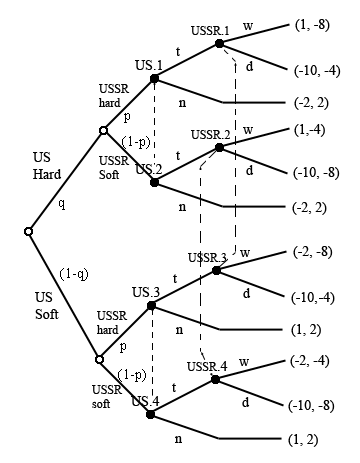
US and Soviet Payoffs Unknown

USSR Hard (info set = {USSR.1, USSR.3})
Expected Payoff to Soviets for withdraw: q*p*(-8) + (1-q)*p*(-8)
= p*(-8q - 8 + 8q)
= p*(-8).
Expected Payoff to Soviets for defy: q*p*(-4) + (1-q)*p*(-4)
= p*(-4q - 4 + 4q)
= p*(-4).
Therefore, soviets always defy at this information set because -4p > -8p (...since 0 <= p <= 1).
Note: you can ignore the p's here because the Soviets know they are hard. I left them in so that you would not get confused.
USSR Soft (info set = {USSR.2, USSR.4})
Expected Payoff to Soviets for withdraw: q*(1-p)*(-4) + (1-q)*(1-p)*(-4)
= (1-p)*(-4q -4 + 4q)
= (1-p)*-4.
Expected Payoff to Soviets for defy: q*(1-p)*(-8) + (1-q)*(1-p)*(-8)
= (1-p)*(-8q -8 + 8q)
= (1-p)*-8.
Therefore, soviets always withdraw at this information set because -4(1-p) > -8(1-p).
US Hard (info set = {US.1, US.2})
Expected Payoff to Americans for threaten: q*p*(-10) + q*(1-p)*1
= q*(-10p + 1 - p)
= q*(-11p + 1).
Expected Payoff to Americans for not: q*p*(-2) + q*(1-p)*-2
= q*(-2p - 2 + 2p)
= q*(-2).
Therefore, Americans threaten at this information set if and only if.
q*(-11p + 1) > q*(-2)
= -11p > -3
= p < 3/11
Note: the Americans threaten depending upon p, similar to what we discussed in class.
US Soft (info set = {US.3, US.4})
Expected Payoff to Americans for threaten: (1-q)*p*(-10) + (1-q)*(1-p)*-2
= (1-q)*(-10p - 2 + 2p)
= (1-q)*(-8p - 2).
Expected Payoff to Americans for not: (1-q)*p*1 + (1-q)*(1-p)*1
= (1-q)*(p + 1 - p)
= (1-q)*1.
Therefore, Americans threaten at this information set if and only if.
(1-q)*(-8p - 2) > (1-q)*1
= -8p - 2 > 1
= -8p > 3
= p < -3/8
which is never the case. Hence, the Americans will never threaten at this information node. In other words, if the Americans are soft, they back down.
The Sequential Equlibrium is conditioned on player type and can be written:
{([not | soft], [threaten | p < 3/11]); ([defy | hard], [withdraw | soft])}.
Note: everything before the ";" is the strategy of the US. Everything after is the strategy for the USSR.